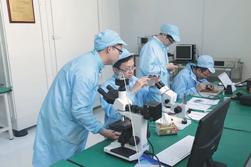 Scientists test MEMSensing Microsystems (Suzhou) Co Ltd's products at a facility in Suzhou. (PHOTO PROVIDED TO CHINA DAILY)
Scientists test MEMSensing Microsystems (Suzhou) Co Ltd's products at a facility in Suzhou. (PHOTO PROVIDED TO CHINA DAILY)
Depressed market sentiment due to COVID-19 earlier this year did not hinder the listing of MEMSensing Microsystems (Suzhou) Co Ltd, whose bourse debut marked the first of its kind in the A-share market.
Located in the China (Jiangsu) Pilot Free Trade Zone Suzhou Area, MEMSensing successfully floated on the technology-heavy STAR Market in Shanghai on Aug 10, making it the first A-share company with core operations in the sale and research of micro-electro-mechanical system (MEMS) sensors.
Founded in 2007, MEMSensing is seeking cooperation with leading market players such as Huawei, Xiaomi, Alibaba and Sony, with its technologies applied in smartphones, tablets, wearables and cars. According to global market consultancy IHSMarkit, it became the world's fourth largest MEMS microphone provider in 2018.
Although CCID Consulting estimated that China's MEMS market value will top over 850 billion yuan (US$124 billion) in 2021 with the compound average growth rate between 2018 and 2021 reaching 19 percent, there was no MEMS industrial chain in the country when MEMSensing was founded in Suzhou, Jiangsu province, 13 years ago, said the company's board secretary Dong Mingyan. Therefore, the company had to involve itself into every stage of the MEMS industry, including chip design, wafer production and semiconductor packaging.
"We have done more than what is required for a MEMS company, with our operations covering research and development, production and connecting the entire supply chain. It was a painstaking process. But by grasping core technologies at every production step, we can be completely independent, with no reliance on foreign suppliers," he said.
According to its half-year fiscal report released in August, MEMSensing's sales revenue and net profit contracted by 3.56 percent and 40.77 percent year-on-year, respectively, in the first six months.
Efforts from the local government have fueled MEMSensing's growth. China Semiconductor Industry Association's MEMS Branch is located in the Suzhou FTZ area. The easier access to various resources is a major attraction for MEMS companies, Dong said.
ALSO READ: Semiconductor industry on steady track despite outbreak
"Complete industrial chains have been set up in the FTZ area. Industrial parks have been built specifically for biomedical, information technology and MEMS companies. While communication can thus be carried out among companies specializing in the same industry, companies in different sectors can also easily find common ground as they are located in the same area," he said.
Dong said a large number of staff responsible for business solicitation in the FTZ area have academic backgrounds in engineering.
"They may not be experts in specific detailed technological advancement, yet their background knowledge can help companies find resources and build technology platforms. The local administrative body prioritizes the government services provided to companies, making the business environment there always friendly," he said.
According to its half-year fiscal report released in August, MEMSensing's sales revenue and net profit contracted by 3.56 percent and 40.77 percent year-on-year, respectively, in the first six months.
But the company is not too concerned about the temporary decline. As Dong explained, market sentiment in consumer products was impaired by COVID-19 during the first half, which as a result impacted equipment providers such as MEMSensing. But production capacity remained unchanged during the period, Dong said.
More importantly, the company has made huge investment in a new packaging assembly line, which resulted in the recent discouraging numbers.
READ MORE: FTZs sustain foreign trade
While the company has reached most small and medium-sized clients with its current production capacity, it is aiming to reach larger companies. Therefore, a self-operated packaging assembly line is a must as it would allow MEMSensing to meet huge demand by higher-end clients and better control the proportion of qualified products.
"We will establish a higher entry barrier for our competitors as we have built a complete supply chain. You have to squat lower if you want to jump higher," he said.
Contact the writer at shijing@chinadaily.com.cn


